by Sam Callander
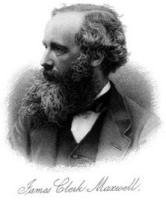 James Clerk Maxwell, whose death occurred on 5th November 1879, at the early age of 48, was destined to become one of the 19th century’s greatest scientific figures, and he may well prove to be one of Scotland’s greatest sons. He put an end to speculation as to the nature of light with his discovery that it is a form of wave motion, by which electro-magnetic waves travel through a medium at a speed, which is determined by the electric and magnetic properties of that medium. This is still the basis for explanations of all the phenomena of light and accompanying optical properties. He was unable to test his theory, but follow-up developments by others have given the world all forms of radio communications, including broadcasting and television, radar and navigational aids, and more recently the applications of radio to the control of rockets and satellites.
James Clerk Maxwell, whose death occurred on 5th November 1879, at the early age of 48, was destined to become one of the 19th century’s greatest scientific figures, and he may well prove to be one of Scotland’s greatest sons. He put an end to speculation as to the nature of light with his discovery that it is a form of wave motion, by which electro-magnetic waves travel through a medium at a speed, which is determined by the electric and magnetic properties of that medium. This is still the basis for explanations of all the phenomena of light and accompanying optical properties. He was unable to test his theory, but follow-up developments by others have given the world all forms of radio communications, including broadcasting and television, radar and navigational aids, and more recently the applications of radio to the control of rockets and satellites.
James Clerk Maxwell was born on 13th June 1831, at 14 India Street, Edinburgh, and a memorial-plaque on the outside wall of the house commemorates this. Two Scottish families were intermingled in his ancestry-the Clerks and the Maxwells.
The Clerks of Penicuik were a distinguished family, having come from Aberdeenshire, which county they had been forced to leave on account of their loyalty to Queen Mary. They settled in Montrose for two generations until a grandson, John who had gone to Paris and been successful in commerce, returned and bought the barony of Penicuik in Midlothian. He married Mary Gray, daughter of Sir William Gray of Pittendrum, whose wife had attended Queen Mary during the last tragic days of her life, receiving her necklace as a parting gift.
The eldest son of John Clerk and Mary Gray became a baronet and married a granddaughter of Sir William Drummond of Hawthornden and it was their granddaughter, Dorothea, and her husband, who was also her cousin, who were the great-grandparents of James Clerk Maxwell.
The scientist’s grandfather, James Clerk, was a captain in the East India Navy, and an amusing story is told of how his ship was wrecked in the Hooghli, and he managed to swim ashore using the bag of his pipes as a float. Having gained dry land, he immediately put the pipes to their proper use and played ” an unco fit ” which not only cheered the survivors, but also kept the tigers at bay!
John, the younger son of Captain James Clerk, inherited what was left of Middlebie, an estate of considerable size, which at one time stretched from Dumfries-shire into Kirkcudbrightshire. By the conditions of the entail under which it had descended from the Maxwells, Middlebie and Penicuik could not be held simultaneously, so Sir George Clark relinquished Middlebie in favour of his brother, the above John Clark who added Maxwell to his name. He married his friend’s sister, Miss Frances Cay of Northumberland and they were the parents of Professor James Clerk Maxwell. As there was no house for the Laird, and the ground at Middlebie proved unsuitable, some of the adjoining land was secured, on which was built the new house. As it was situated beside the Lair Burn, the name Glenlair was adopted instead of Middlebie.
At a very early age, before he was three, Clerk Maxwell was on the quest for knowledge, asking endless questions. ” Show me how it doos ” was ever on his lips as well as ” What’s the go o that?” If the answer did not seem adequate he would ask “But what is the particular go of that?” When anyone remarked about something being a certain colour he would ask ” But how d’ye know it’s red?” or ” How d’ye know it’s blue?” Maybe even at this early stage colour had a special interest for him. His aunt, Miss Cay, declared it was humiliating to be asked so many awkward questions by a “child like that.” To a friend he once remarked that his first recollection of anything was lying on the grass at Glenlair in front of the house, wondering.
The urge to peer beyond the bounds of knowledge was stirring in him before he had power to express it, and not being content with wondering he had to discover and apply, and this was shown when, at two and a half, he was given a tin plate to play with. Catching the sun in the plate, he made the reflection go round and round the room. He sent Maggie, the servant, to fetch Papa and Mama, and when they arrived he spun the reflection across their faces. When his father asked him what he was doing, he answered with enthusiasm, “It is the sun and I got it in with the tin plate.” Colour and light, in both of which he did so much work later in life!
His father was a very practical man and James became his constant companion. He loved making things and on wet days he would busy himself with knitting, basket-making, seal making, and sometimes he taught the servants to make baskets.
Probably encouraged by his mother, who saw to his education up to the time of her death, James was an avid reader and had a wonderful memory. Professor Lewis Campbell, in his Life of James Clerk Maxwell, gives a very full record of his childhood and tells that in the Clerk Maxwell household the Bible was not only read but studied, and by the time James was eight years old he could recite all 176 verses of the 119th Psalm as well as telling the place of almost any verse quoted in the Book of Psalms.
He had an innate reverence for sacred things, and Lewis Campbell recalls the scene in Church. “The absolute gravity of his face was itself a study. He always sat very still, with one hand lightly over the other, and not moving a muscle however long the sermon might be. Days afterwards he would show by some remark that the whole sermon, whether good or bad, had been photographed upon his mind.” James Clerk Maxwell also had a great sense of humour, although at one period, when he felt it was not being appreciated, he would quash a joke when he felt one coming on! He would write long letters to his father, often illustrated with clever sketches and humorous verses, sometimes turning the letter into anagrams. He addressed one envelope thus:
Posty Knows Where,
Kirkpatrick Durham,
Dalbeattie.
The letter reached its destination.
The story is told of him that when he went to Cambridge in 1857, he took one of his experimental tops with him from Aberdeen. One evening he showed it to some college friends who left it spinning in his room. Next morning he saw one of these friends coming across the court, so he set the top spinning again and went back to bed pretending to be asleep. It is reported the trick was successful.
During his schooldays he became adept with the ” deil on two sticks,” or Diablo . . . For this game a “devil” or double cone is maintained in rotation and controlled by the narrow part resting on a string suspended between two sticks held in the hands of the player. On obtaining considerable speeds the double cone takes on some of the curious properties associated with a gyroscope.
At fourteen years of age he achieved the remarkable distinction of having a paper “On the Description ion of Oval Curves” read to the members of the Royal Society of Edinburgh, but because of his youth his paper was read by Professor Forbes.
At sixteen he entered the University of Edinburgh and at nineteen he proceeded to Cambridge as an undergraduate at Peterhouse but transferred to Trinity after a few months where there seemed to be a better chance of obtaining a Fellowship. Because of his wide range of mathematical knowledge, exceptional in a young man, the change seemed justified and this brought the young Maxwell into frequent contact with many outstanding undergraduates. He was elected a Fellow of Trinity in 1855 and the next year he was appointed a Professor of Natural Philosophy at Aberdeen’s Marischal College.
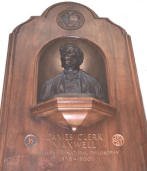 On taking up his duties at Aberdeen, Clerk Maxwell gave particular attention to the preparation of striking experiments to illustrate his lectures. A favourite demonstration as recalled by a farmer, was the mounting of a member of his class on an insulated stand while Maxwell “pumpit him fu o’ electricity so that his hair stood oot on end.”
On taking up his duties at Aberdeen, Clerk Maxwell gave particular attention to the preparation of striking experiments to illustrate his lectures. A favourite demonstration as recalled by a farmer, was the mounting of a member of his class on an insulated stand while Maxwell “pumpit him fu o’ electricity so that his hair stood oot on end.”
At the same time he continued his individual scientific work and an important feature of this was his investigation of the stability of Saturn’s rings. His essay on “The Motions of Saturn’s Rings,” the result of long and thorough investigation, gained him the Adams Prize and set him at once in the forefront of research workers in mathematical physics.
His stay in Aberdeen was brought to an end in the fusion of the two colleges there in 1860, and he moved to London where he was appointed to the Chair of Natural Philosophy and Astronomy at King’s College. Here he proceeded to produce some of his most important papers. He was 29 when he was awarded the Rumford Medal of the Royal Society for his experiments resulting in verifying the theory of colour vision, and establishing the subject of the composition of colours as a branch of mathematical physics. He had shown, beyond any doubt, that all colours experienced in nature are combinations of red, blue and yellow, the three primary colours of the spectrum.
In an 1855 paper he had invented the additive process of colour photography, which in 1861 helped, in his taking the first ever colour photograph. The original print is still preserved at Cambridge, where, after a spell of retirement at Glenlair in Scotland, he was persuaded to become the first Professor of Experimental Physics and to plan and arrange the Cavendish Laboratory. It was during his stay at Glenlair that he did his brilliant and valuable work on his electric magnetic theory and in this field he stands as prominent as did Newton and Faraday in theirs.
In 1873, Clerk Maxwell’s Discourse on Molecules, of major importance to physics, was delivered before the British Association at Bradford, and in the same year he published a book “Electricity and Magnetism” which for years after his death was the main inspiration for all books on electrical questions.
During his last years most of his time was occupied editing the Cavendish Manuscripts at the request of the Duke of Devonshire, the Chancellor of the University. In 1877, he felt the first symptoms of the illness that proved fatal, but not regarding his condition as serious he didn’t seek the advice of his doctor. His health gradually declined and on 5th November, 1879, he was released from the “exquisite pain” from which he had had little relief. His remains were brought back to Galloway and buried beside those of his parents in the ruins of the old Kirk at Parton.
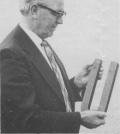 Mr Sam Callander, the writer of this article, with an outsize magnet made and used by Professor Clerk Maxwell. Sam is a Trustee of the Maxwell at Glenlair Trust.
Mr Sam Callander, the writer of this article, with an outsize magnet made and used by Professor Clerk Maxwell. Sam is a Trustee of the Maxwell at Glenlair Trust.

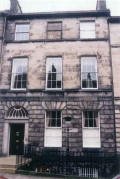

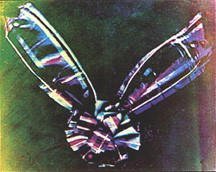
1 comments
Thank you so much for this interesting website! I am an elementary school science teacher and have long been fascinated by Maxwell, his life, discoveries and contributions to the world. I would love to visit Glenlair some day. At our school, we actually have a teacher from Scotland. I’m going to ask her if she ever visited Glenlair!
We take so much for granted in our modern world. It would not be what it is without Maxwell.
Thank you!
John Frassinelli
Memphis, TN, USA